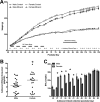Intermittent voluntary ethanol consumption combined with ethanol vapor exposure during adolescence increases drinking and alters other behaviors in adulthood in female and male rats
- PMID: 30293056
- PMCID: PMC6193864
- DOI: 10.1016/j.alcohol.2018.04.003
Intermittent voluntary ethanol consumption combined with ethanol vapor exposure during adolescence increases drinking and alters other behaviors in adulthood in female and male rats
Abstract
Epidemiological studies suggest that binge drinking is prevalent among adolescents, and may result in neurobehavioral consequences. Animal models provide the experimental control to investigate the consequences of "binge" alcohol exposure during this neurodevelopmental epoch. The current study used an animal model that combined an intermittent pattern of alcohol vapor exposure with voluntary drinking of 20% unsweetened alcohol in adolescent male and female Wistar rats (postnatal day [PD] 22-62), in order to test for potential differences in behavioral changes, ethanol drinking, and hypocretin/orexin (Hcrt/OX) signaling associated with exposure status. Two weeks after discontinuation of the alcohol vapor exposure and drinking during adolescence, rats were tested in adulthood for anxiety-like behaviors using a modified open-field conflict task, pre-pulse facilitation of startle response, light/dark box, and marble burying test. Adolescent alcohol exposure led to overall decreased startle response and increased behavioral arousal in the light/dark chamber during adulthood. Additionally, male rats demonstrated more disinhibited behavior during the conflict task compared to females, and female rats exhibited more rearing behavior during the light/dark test. Rats were also given a 2-bottle choice test that resulted in adolescent alcohol-exposed rats drinking significantly more alcohol in adulthood. Further, female rats also consumed more alcohol in adulthood compared to males. Estrous cycle phase did not account for any of the sex differences observed in the behavioral measures. Histological results indicated that adolescent alcohol did not alter Hcrt/OX-1 or Hcrt/OX-2 receptor mRNA expression levels in adult rats compared to control adults. However, female rats expressed a higher level of Hcrt/OX-1 and Hcrt/OX-2 receptor mRNA in the frontal cortex compared to males. These data suggest that our current model of intermittent ethanol exposure in adolescence can modestly affect both behavior and future consumption of alcohol and that Hcrt/OX receptor signaling differs between males and females.
Keywords: Adolescence; Alcohol drinking; Female; Hypocretin/orexin; Wistar rats.
Copyright © 2018 Elsevier Inc. All rights reserved.
Conflict of interest statement
None
Figures




References
-
- Acevedo MB, Molina JC, Nizhnikov ME, Spear NE, Pautassi RM. High ethanol dose during early adolescence induces locomotor activation and increases subsequent ethanol intake during late adolescence. Developmental Psychobiology. 2010;52(5):424–40. http://doi.org/10.1002/dev.20444 - DOI - PMC - PubMed
-
- Alaux-Cantin S, Warnault V, Legastelois R, Botia B, Pierrefiche O, Vilpoux C, Naassila M. Alcohol intoxications during adolescence increase motivation for alcohol in adult rats and induce neuroadaptations in the nucleus accumbens. Neuropharmacology. 2013;67:521–31. http://doi.org/10.1016/j.neuropharm.2012.12.007 - DOI - PubMed
-
- Amodeo LR, Kneiber D, Wills DN, Ehlers CL. Alcohol drinking during adolescence increases consumptive responses to alcohol in adulthood in Wistar rats. Alcohol. 2017;59:43–51. http://doi.org/10.1016/j.alcohol.2016.12.002 - DOI - PMC - PubMed
-
- Anderson P, Baumberg B. Alcohol Policy: Who should sit at the table? Addiction. 2007;102(2):335–336. http://doi.org/10.1111/j.1360-0443.2006.01713.x - DOI - PubMed
-
- Assanangkornchai S, Mukthong A, Intanont T. Prevalence and patterns of alcohol consumption and health-risk behaviors among high school students in Thailand. Alcoholism, Clinical and Experimental Research. 2009;33(12):2037–46. http://doi.org/10.1111/j.1530-0277.2009.01043.x - DOI - PubMed
Publication types
MeSH terms
Substances
Grants and funding
LinkOut - more resources
Full Text Sources
Medical

